|
Siunik, a province to the Southeast of Lake Sevan, was
one such area, and it was here that the last two Armenian
medieval academics - Gladzor and Tatev - were founded and
prospered. The Gladzor academy, or university, set up in the
second half of the thirteenth century on the basis of a monastery,
had a very high reputation throughout the country. It was
not a monastery in the ordinary sense of the word, but a true
university, and many people from different parts of Armenia,
even from far-away Cilicia, came to Gladzor to study or to
perfect their knowledge.
Among the teachers
at Gladzor were many celebrated scholars of the time - Nerses
Mshetsi, founder of the university, a scholar who "knew the
tongue of the Greeks well", and Yesai Ntchetsi, rhetorician,
philosopher and a prominent political figure. Many future
famous scientists and historians were educated at the University
of Gladzor, which was also a cultural centre with its own
manuscript tradition and school of book illumination.
The miniature art
in Siunik was strongly influenced by its earlier tradition
of ornamentation. But even though the khorans and marginals
mostly comprised motifs and symbols of pre-Christian art -
totems, allegories of good and evil or of the forces of nature
(dragons, unicorns, griffins, etc.), the Siunik miniature
of the thirteenth century developed a realistic style. Another
distinctive feature of Siunik art of that period was its affinity
to the Cilician artistic tradition, no doubt because the academies
in Siunik attracted laymen and priests from Cilicia; some
of whom must have been artists.
Local traditions
found their most consistent manifestation in work by the artist
Mateos and Momik, architect,stone-carver and miniaturist.
Their work is remarkable for its florid style and its a poetic
character hitherto unknown to medieval Armenian art. These
qualities are particularly apparent in Momikís khachkars,
whose delicate carving makes one forget the solidity and weight
of stone.
|
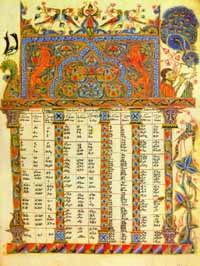
Khoran
of the Bible
1318, Gladzor monastery, Siunik
Written by Stepanos, illuminated by Toros Toronatsi.
|
Taronatsi was
one of the most productive artists of the Gladzor School.
A pupil of Yesai Ntchetsi, he was not only a talented miniaturist
but also a famous poet of his time. His early miniatures
were strongly influenced by the ancient traditions of local
pictorial art. The khorans and borders abound in fantastic
monsters - human-headed birds (sometimes having two heads),
snakes and dragons, symbols of evil, fighting with each
other or tearing at their prey, or else, according to the
Christian tradition, slain by warrior-saints who are trampling
their prostrate bodies. |
|
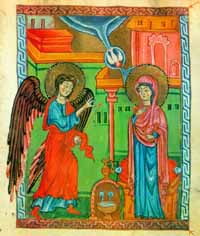
The
Annunciation
The Gospels
1323, Gladzor Monastery, Siunik
Written and illuminated by Toros Taronatsi
|
Later
works by Taronatsi show influences by Cilician miniature
painting, concerned with the decorative character of the
illumination combined with iconography features and images,
as with this illumination of the Annunciation in the 1323
Gospels.
The
Gladzor academy ceased to exist with the death of Yesai
Ntchetsi in 1338, but its traditions survived in other
monastery schools of Armenia, particularly in the University
of Tatev which, after Gladzor, was the second most famous
educational institution in Armenia.
|
|
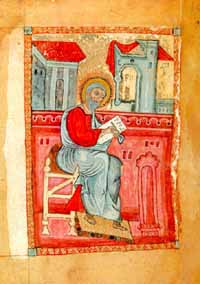
St. Mathew
The Gospels of 1297
1297, written in the village of Eligis by Hovhannes
1378, illuminated in the monastery of Tatev by Grigor
Tatevatsi, 1378
|
Tatevatsi -
a prominent politician, philosopher and artist-was the
head of the Tatev academy for many years. The distinctive
features of his miniatures are their skilful use of folk
ornamental motifs, the way he lent an intimacy to the
depicted scenes, and their almost fresco like appearance.
In this miniature,
the background buildings resemble existing buildings of
the time in Siunik. The same is true of the chair on which
the evangelist is seated: similar wooden chairs are still
in use in Armenian villages.
|
|
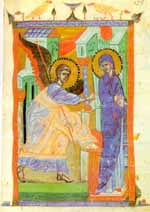
The
Annunciation
The Gospels
14th century, the Crimea(?)
Names of scribe and illuminator unknown
|
Among
those Matenadaran manuscripts whose colophons have been
lost there are three remarkable fourteenth-century, whose
origin has only recently been established. The style of
illumination in these Gospels is a synthesis of Cilician
tradition and the traditions of the Byzantine Renaissance,
with its Hellenistic flavour and a quest for a more realistic
pictorial representation. |
|
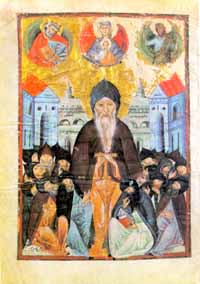
The
Psalms as Interpreted by Grigor Tatevatsi
Late 14th or early 15thcentury,
place of production unknown
Scribe unknown, illuminated by Tadeos Avraments (?)
|
The
anonymous artist must have actually met Grigor Tatevatsi,
celebrated scholar, philosopher and artist, since the details
in the portrait are very natural, including the half-closed
left eye and slightly drooping mouth, perhaps the result
of an illness or stroke. The illumination breaks with medieval
tradition by depicting a specific person. Very like recorded
descriptions of the scholarís appearance, this miniature
was regarded at the time as an authentic likeness, and copied
by different artists over the years. |
Towards the end
of the fourteenth century the economic and political situation
in Armenia grew steadily worse: one by one monastic scriptoria
cut down on their production of manuscripts. The art of manuscript
illumination was only kept alive in the remote monasteries
of South and East Armenia. The schools of illumination in
the province of Vaspurikan and nearby came to represent the
highest achievements of Armenian miniature painting.
|

